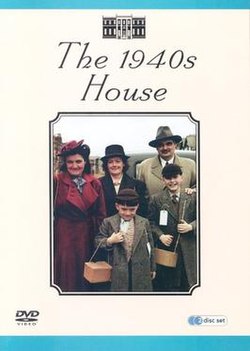The 1940s House
| The 1940s House | |
|---|---|

Region 2 PAL DVD (UK)
|
|
| Genre | Historical reality television |
| Country of origin | United States |
| No. of seasons | 1 |
| No. of episodes | 5 |
| Production | |
| Executive producer(s) | Alex Graham |
| Running time | 45 min. |
| Release | |
| Original network |
Channel 4 (UK) PBS (US) |
| Original release | 4 November 2002 |
| External links | |
| Website | |
The 1940s House is a British historical reality television programme made by Wall to Wall/Channel 4 in 2001 about a modern family that tries to the live as a typical middle-class family in London during The Blitz of World War II. It was shown on Channel 4 in the United Kingdom in 2001, and in 2002 on PBS in the United States and ABC Television in Australia. It also aired on TVNZ in New Zealand. The series was narrated in the UK by Geoffrey Palmer.
The success of The 1900 House led Channel 4 to revisit the idea of taking a family back in time again.The 1940s House was originally conceived with only four episodes. The concept of the show was different from that of The 1900 House: instead of focusing on the family's ability to cope without modern conveniences, this one focused on the family's ability to pull together under uncertainty and fear.
The house is at 17 Braemar Gardens, West Wickham, Kent, in the United Kingdom (now a suburb of Greater London). Series art director Lia Kramer, who had helped create The 1900 House, identified the property and oversaw its restoration. The Tudorbethan house, originally built in 1932 by Bradfield Bros & Murphy, was retrofitted to reflect the technology and fashions of a middle-class English home of the late 1930s. It is a gable-ended, three-bedroom, semi-detached home. A boiler fueled by coke provided hot water, and there was no telephone or refrigerator. Sold for 875 pounds in 1932, the producers purchased the house for ₤187,000 in 1999. The house was in excellent structural condition, and no major renovations had occurred. Restoration included the removal of central heating and radiators, the custom-fitted kitchen cabinets and appliances, and the carpeting. Removal of the carpeting revealed checkerboard floor tiles. Several fireplaces were restored to working condition, and the original French doors which led outside to the patio were reinstalled. The producers discovered that the house had incurred bomb damage during World War II, and that the owner of the home had suffered a fatal heart attack putting out a fire caused by a bomb in the backyard garden in 1942. The home's original paint was uncovered, and discovered to be bright blues, pinks, and greens. 1940s-era floral wallpaper was purchased and reinstalled in some areas of the home (including the entryway). The house was decorated in a style typical of the 1930s, which included some used Victorian furniture and a small number of Art Deco pieces. The existing beds were replaced by iron bedsteads (including twin beds for Michael and Lyn). When neighbours learned of the project, many donated period home furnishings for free. A 1930s-style gas-fired cooking stove, Belfast sink, draining board, metal-topped table, and fold-down work shelf were installed in the kitchen. The garden was revamped to be typical of a victory garden.
...
Wikipedia
